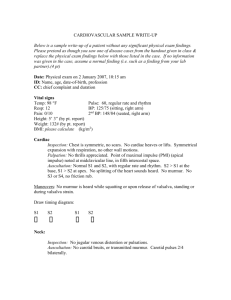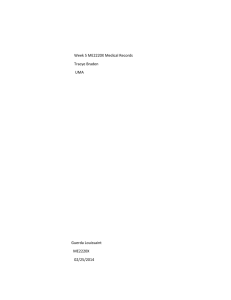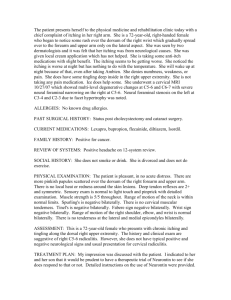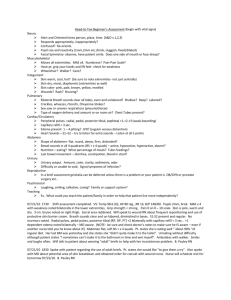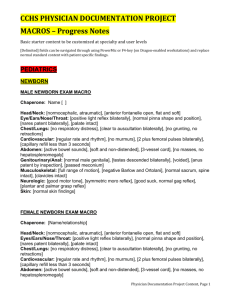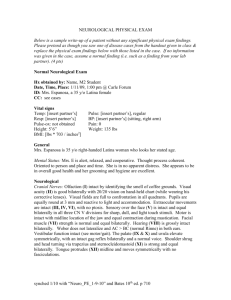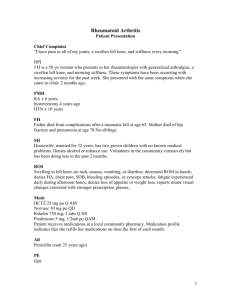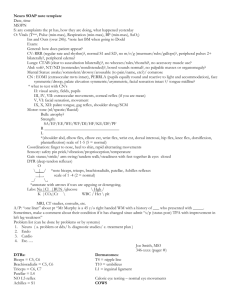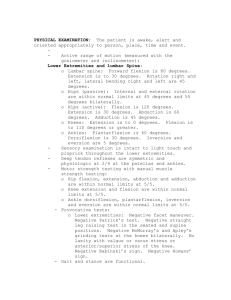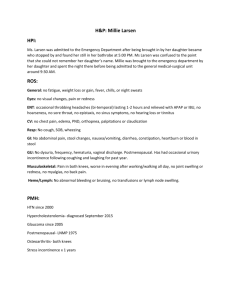som201a
advertisement
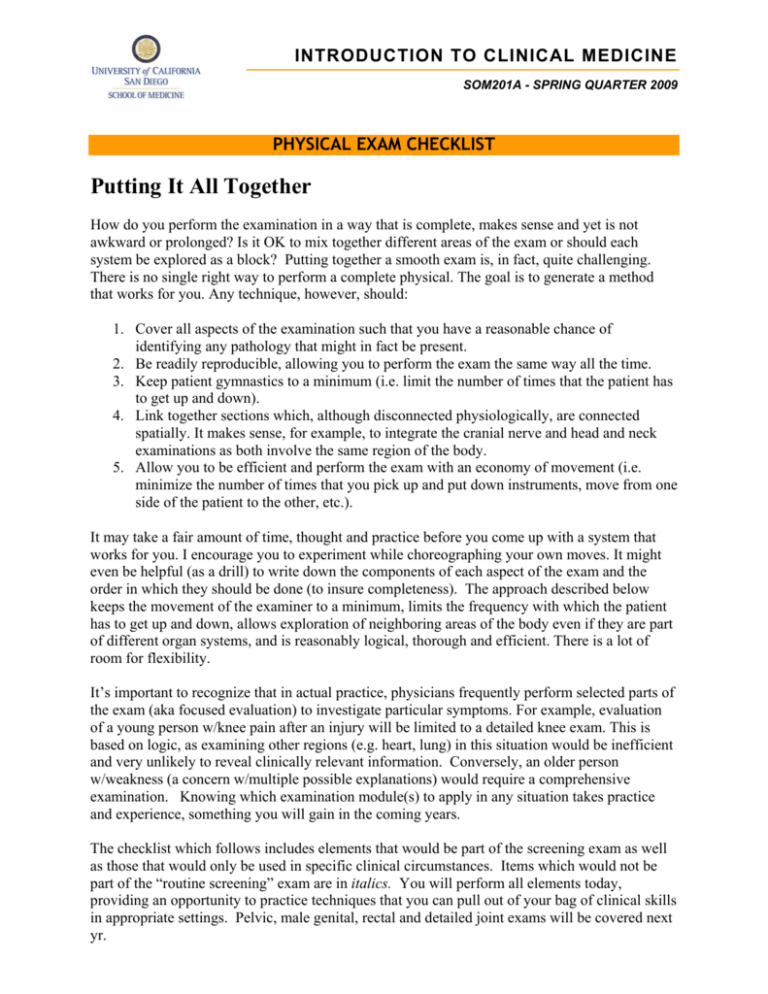
INTRODUCTION TO CLINICAL MEDICINE SOM201A - SPRING QUARTER 2009 PHYSICAL EXAM CHECKLIST Putting It All Together How do you perform the examination in a way that is complete, makes sense and yet is not awkward or prolonged? Is it OK to mix together different areas of the exam or should each system be explored as a block? Putting together a smooth exam is, in fact, quite challenging. There is no single right way to perform a complete physical. The goal is to generate a method that works for you. Any technique, however, should: 1. Cover all aspects of the examination such that you have a reasonable chance of identifying any pathology that might in fact be present. 2. Be readily reproducible, allowing you to perform the exam the same way all the time. 3. Keep patient gymnastics to a minimum (i.e. limit the number of times that the patient has to get up and down). 4. Link together sections which, although disconnected physiologically, are connected spatially. It makes sense, for example, to integrate the cranial nerve and head and neck examinations as both involve the same region of the body. 5. Allow you to be efficient and perform the exam with an economy of movement (i.e. minimize the number of times that you pick up and put down instruments, move from one side of the patient to the other, etc.). It may take a fair amount of time, thought and practice before you come up with a system that works for you. I encourage you to experiment while choreographing your own moves. It might even be helpful (as a drill) to write down the components of each aspect of the exam and the order in which they should be done (to insure completeness). The approach described below keeps the movement of the examiner to a minimum, limits the frequency with which the patient has to get up and down, allows exploration of neighboring areas of the body even if they are part of different organ systems, and is reasonably logical, thorough and efficient. There is a lot of room for flexibility. It’s important to recognize that in actual practice, physicians frequently perform selected parts of the exam (aka focused evaluation) to investigate particular symptoms. For example, evaluation of a young person w/knee pain after an injury will be limited to a detailed knee exam. This is based on logic, as examining other regions (e.g. heart, lung) in this situation would be inefficient and very unlikely to reveal clinically relevant information. Conversely, an older person w/weakness (a concern w/multiple possible explanations) would require a comprehensive examination. Knowing which examination module(s) to apply in any situation takes practice and experience, something you will gain in the coming years. The checklist which follows includes elements that would be part of the screening exam as well as those that would only be used in specific clinical circumstances. Items which would not be part of the “routine screening” exam are in italics. You will perform all elements today, providing an opportunity to practice techniques that you can pull out of your bag of clinical skills in appropriate settings. Pelvic, male genital, rectal and detailed joint exams will be covered next yr. INTRODUCTION TO CLINICAL MEDICINE SOM201A - SPRING QUARTER 2009 Name of Student Examiner: Name of Student “Patient”: Please place a check mark (9) in the column that best describes your observation using the following key: Yes = behavior described was done completely with the correct technique Sort of = behavior described was done partially or with the incorrect technique No = behavior was not done Yes VITAL SIGNS & GENERAL OBSERVATION: 1. Washes hands 2. Asks patient to change into gown (if not already done) & sit on exam table 3. Observes patient’s general appearance, clothing, eagerness to interact, mood, etc. 4. Palpates and counts radial pulse for at least 15 seconds 5. Respiratory rate (RR): With fingers still on patient’s wrist, counts RR 6. Measures blood pressure in one arm. 7. Measures orthostatic vitals signs (pulse & BP) if clinical situation warrants (e.g. blood/volume loss, dizziness). 8. Perform general survey of skin – looking for cancer, other abnormal growths UPPER EXTREMITIES: 1. Inspects: nails, hands, arms 2. Palpate for axillary adenopathy (if a breast exam were performed, axilla could be examined at that time) HEENT: Sort Of No INTRODUCTION TO CLINICAL MEDICINE SOM201A - SPRING QUARTER 2009 Yes Eyes 1. Assesses visual acuity (CN 2) 2. Assesses visual fields in both eyes (CN 2) 3. Tests Extra-ocular movements in all directions of gaze (CN 3, 4, 6) 4. Inspects eyelids, peri-orbital area, conjunctivae, cornea, sclerae (using opthalmoscope if any abnormalities), 4. Tests pupillary reponse to light and accommodation (CN 2, 3) 5. Corneal reflex (CN 5, 7) (if concern re loss of function) 6. Fundoscopic exam: finds red reflex, optic disc; inspects Retina Head 1. Inspects & palpates scalp 2. Palpates major lymph node areas 3. Facial symmetry & expression 4. Facial symmetry, muscles mastication Ears 1. Screens hearing w/rubbing fingers, ticking watch or whispered word (CN 8) 2. Performs Weber test (if hearing diminished) 3. Performs Rinne test (if hearing diminished) 4. Inspects external ear 5. Uses otoscope to inspect external canal, tympanic membranes bilaterally Nose & Sinuses 1. Assesses ability to inhale through each nostril, Assesses ability to smell w/alcohol pad (if problems with smell) 2. Inspects nasal septum, turbinates, mucosa using otoscope 3. Palpates maxillary & frontal sinuses for tenderness (if signs or symptoms sinusitis) Sort Of No INTRODUCTION TO CLINICAL MEDICINE SOM201A - SPRING QUARTER 2009 Yes Throat and Mouth 1. Asks the patient to show their teeth & stick out their tongue; Say “Ah,” observing symmetric rise uvula, palate (CN 9, 10, 12). 2. Assesses gag (e.g. after stroke &/or other concern re ability to protect their airway & swallow) 3. Using otoscope & tongue depressor, examines oral cavity, assesses condition of teeth. Neck 1. Asks the patient to shrug their shoulders & turn their head from side to side (CN 11). 2. Inspects for asymmetry, masses, position of trachea, thyroid enlargement 3. Palpates thyroid 4. Assesses range of motion of neck BACK EXAM: 1. Inspects spine for asymmetry, curvature or mal-alignment 2. Palpates lightly & w/ fist over spinous processes for tenderness (if patient has back pain) THORAX AND LUNG EXAM: 1. Inspects chest for effort of breathing, shape of chest/thorax, surface abnormalities (scars, etc.) 2. Palpation: Assesses respiratory expansion (posteriorly) 3. Palpation: Assesses tactile fremitus bilaterally, posteriorly & anteriorly (if abnormality on percussion or auscultation) 4. Percusses, alternating R & L lung fields posteriorly topÆbottom; & anteriorly, 5. Determines diaphragmatic excursion using percussion 6. Auscultation Sort Of No INTRODUCTION TO CLINICAL MEDICINE SOM201A - SPRING QUARTER 2009 Yes a. R & L lung fields posteriorly comparing side to side b. right middle lobe c. anterior fields bilaterally CARDIAC EXAM: HEART: 1. Inspects precordium for obvious cardiac motion 2. Palpates precordium for lifts/heaves or thrills 3. Palpates for apical impulse (PMI) 4. Auscultates in at least four areas (mitral, tricuspid, aortic and pulmonic) w/diaphragm of stethoscope 5. Auscultates in areas of the LV with bell of stethoscope (for S3 and S4) JVP: 1. Locates jugular venous pulsations in the neck 2. Measures jugular venous pressure CAROTID ARTERIES: 1. Palpates carotid artery pulse bilaterally (NOT simultaneously) 2. Auscultates carotid artery for bruits bilaterally ABDOMEN: 1. Inspects for asymmetry, masses, superficial abnormalities (e.g. scars), contour 2. Auscultates before palpation – bowel sounds & renal artery bruits 3. Percusses 4 quadrants for tympany & dullness 4. Percusses vertical span of liver in mid-clavicular line 5. Palpates lightly throughout 6. Palpates more deeply Sort Of No INTRODUCTION TO CLINICAL MEDICINE SOM201A - SPRING QUARTER 2009 Yes 7. throughout, feeling in particular for: a. Liver edge (right upper quadrant) b. Spleen (left upper quadrant) c. Mid line for aorta Palpates costo-vertebral angles with fist percussion (if concern for kidney infection) FEMORAL AND INGUINAL AREAS (CAN OMIT THIS WHEN EXAMINING COLLEAGUE): 1. Inspect femoral & inguinal area; then palpate femoral & inguinal nodes 2. Palpates femoral artery pulses bilaterally 3. Auscultates femoral arteries bilaterally for bruits LOWER EXTREMITIES: 1. Knees – observes color, evidence swelling; assess range of motion (active & passive); palpates popliteal (behind knee) pulse 2. Inspects legs for muscle bulk, symmetry, superficial abnormalities, joint abnormalities 3. Inspects feet bilaterally – color, skin abnormalities 4. Palpates dorsalis pedis & posterior tibialis pulses in feet 5. Palpates distal extremities for presence of edema; checks for capillary refill. NEUROLOGICAL EXAM: Cranial Nerves- already covered in Head & Neck, Eye Motor Exam (list below more inclusive then basic screening) Sort Of No INTRODUCTION TO CLINICAL MEDICINE SOM201A - SPRING QUARTER 2009 Yes 1. Determines muscle tone in all extremities 2. Tests shoulder abduction strength bilaterally 3. Tests shoulder adduction strength bilaterally 4. Tests biceps strength (flexion of elbow) bilaterally 5. Tests triceps strength (extension of elbow) bilaterally 6. Tests wrist flexor strength bilaterally 7. Tests wrist extensor strength bilaterally 8. Tests hand grip bilaterally 9. Tests interossei (finger abduction/adduction) strength bilaterally 10. Tests hip flexion strength bilaterally 11. Tests hip extension strength bilaterally 12. Tests knee extension strength bilaterally 13. Tests knee flexion strength bilaterally 14. Tests foot dorsiflexion strength bilaterally 15. Tests foot plantar flexion strength bilaterally Sensory Exam 1. Tests pain (pin prick) v dull touch upper extremities 2. Tests pain (pin prick) v dull touch in lower extremities 3. Tests light touch in upper and lower extremities 4. Tests vibratory sensation in feet 5. Tests vibratory sensation in hands 6. Tests proprioception in feet 7. Tests proprioception in hands Reflexes Tests the following bilaterally 1. Biceps reflex Sort Of No INTRODUCTION TO CLINICAL MEDICINE SOM201A - SPRING QUARTER 2009 Yes Sort Of No 2. Triceps reflex 3. Brachioradialis reflex 4. Patellar reflex 5. Achilles reflex 6. Babinksi Coordination and Cerebellar Function 1. Tests rapid alternating movements (hand slap, toe tap) 2. Tests rapid repeating movements (index finger to thumb) 3. Tests point to point movements (finger to nose, heel to shin) 4. Checks gait: usual gait and heel to toe 5. Asks patient to stand and then walk. Observes gait & heel-to-toe walkig. Checks for Romberg's Sign. 6. Assesses for pronator drift (if concern upper extremity weakness) – this is actually part of motor exam Washes hands. _________________________ Signature of Student Examiner Charlie Goldberg, MD UCSD SOM – 2008 ______________________________ Date
